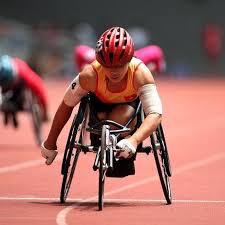Table of Contents
Introduction

The Paralympic Games, a major international multi-sport event involving athletes with disabilities, stand as one of the most significant sporting events in the world. Parallel to the Olympic Games, the Paralympics showcase extraordinary athletic achievements and serve as a powerful platform for promoting inclusivity, breaking down societal barriers, and changing perceptions of disability. From their humble beginnings in the mid-20th century to becoming a global phenomenon, the Paralympic Games have evolved significantly, bringing together athletes from around the world to compete at the highest level.
Origins and Evolution of the Paralympic Games

The Beginnings: Stoke Mandeville Games
The origins of the Paralympic Games can be traced back to the Stoke Mandeville Games, organized by Dr. Ludwig Guttmann, a neurosurgeon at the Stoke Mandeville Hospital in England. In 1948, to coincide with the London Olympics, Dr. Guttmann organized a competition for British World War II veterans with spinal cord injuries. This event, which involved 16 athletes competing in archery, marked the beginning of organized sports for athletes with disabilities. Dr. Guttmann’s vision was not only to provide rehabilitation through sports but also to promote the social integration of people with disabilities.
First Paralympic Games in Rome, 1960
The first official Paralympic Games were held in Rome in 1960, following the success of the Stoke Mandeville Games. These inaugural Paralympics featured 400 athletes from 23 countries, competing in eight sports, including wheelchair fencing, swimming, and athletics. The event was groundbreaking, setting the stage for the Paralympics to become a regular part of the global sporting calendar. The Rome Games were a significant milestone, demonstrating that athletes with disabilities could compete at an elite level and inspiring future generations.
Growth and Expansion
Since the inaugural Games in Rome, the Paralympics have grown exponentially. The number of participating athletes, countries, and sports has increased steadily with each edition. By the 1970s and 1980s, the Paralympics had expanded to include athletes with different types of disabilities, such as visual impairments, amputations, cerebral palsy, and intellectual disabilities. The Games also began to feature more sports, reflecting the diverse abilities of the athletes.
The 1988 Summer Paralympics in Seoul marked a turning point as they were the first Paralympic Games to be held in the same city and venues as the Olympic Games. This established a new standard for the integration of the two events, promoting greater visibility and recognition for Paralympic athletes. The collaboration between the International Olympic Committee (IOC) and the International Paralympic Committee (IPC) has since strengthened, ensuring that the Paralympics are held in conjunction with the Olympics.
Structure and Classification
Disability Categories
The Paralympic Games are unique in their classification system, which ensures that athletes compete against others with similar levels of ability. The classification system is based on the type and degree of disability, allowing for fair competition. Athletes are classified into different categories, such as:
- Amputee: Athletes with limb deficiencies.
- Cerebral Palsy: Athletes with impairments due to cerebral palsy or similar neurological conditions.
- Visual Impairment: Athletes with varying degrees of visual impairment.
- Spinal Cord Injury: Athletes with spinal cord injuries, including paraplegics and quadriplegics.
- Intellectual Disabilities: Athletes with intellectual impairments.
Sports and Events
The Paralympic Games feature a wide range of sports, many of which are adaptations of Olympic sports, while others are unique to the Paralympics. Some of the key sports include:
- Athletics: Track and field events adapted for various disability categories.
- Swimming: Competitions for athletes with physical, visual, or intellectual impairments.
- Wheelchair Basketball: A popular team sport adapted for athletes using wheelchairs.
- Wheelchair Rugby: A high-impact sport for athletes with physical disabilities.
- Boccia: A precision ball sport similar to bocce, designed for athletes with severe disabilities.
- Goalball: A sport specifically designed for visually impaired athletes, where teams attempt to score by throwing a ball with bells into the opponent’s goal.
Each sport has its own set of classifications, ensuring that athletes compete on a level playing field. The classification process is rigorous, involving medical and functional assessments to determine the appropriate category for each athlete.
Impact on Society and Disability Rights
Changing Perceptions
The Paralympic Games have played a crucial role in changing societal perceptions of disability. The Games highlight the abilities and achievements of people with disabilities, challenging stereotypes and breaking down barriers. Paralympians are celebrated for their athletic prowess and determination, inspiring millions of people worldwide. The visibility of the Paralympics has helped to shift the narrative from focusing on disability to celebrating ability, resilience, and excellence.
Advocacy and Legislation
The Paralympics have also been a powerful force for advocacy and change. The Games have brought attention to the need for accessible infrastructure, inclusive education, and equal opportunities for people with disabilities. Many countries have introduced or strengthened disability rights legislation in response to the growing recognition of the capabilities of people with disabilities, as showcased by the Paralympics.
For example, in the United States, the Americans with Disabilities Act (ADA) of 1990, which prohibits discrimination based on disability, was influenced by the growing awareness of disability issues, partly driven by the visibility of the Paralympics. Similarly, other countries have adopted policies and laws to promote inclusion and accessibility, influenced by the global movement for disability rights that the Paralympics have helped to fuel.
Conclusion
The Paralympic Games are more than just a sporting event; they are a celebration of human potential and a powerful platform for promoting inclusion and equality. From their origins in the Stoke Mandeville Games to their current status as a global phenomenon, the Paralympics have transformed the way society views disability and have provided athletes with disabilities the opportunity to shine on the world stage. As the Paralympic Movement continues to grow, it will undoubtedly play a crucial role in shaping a more inclusive future, where all individuals, regardless of their abilities, are recognized for their talents and contributions.
www.youtube.comhttp://Paralympic Games







